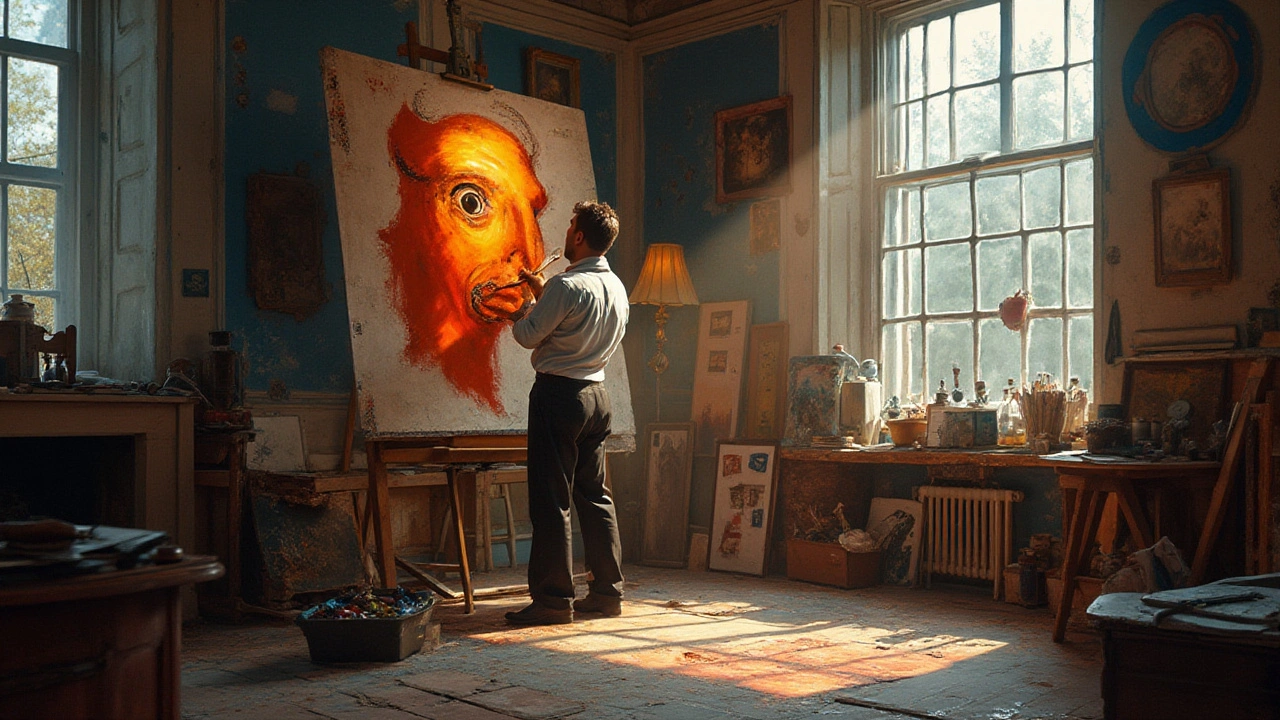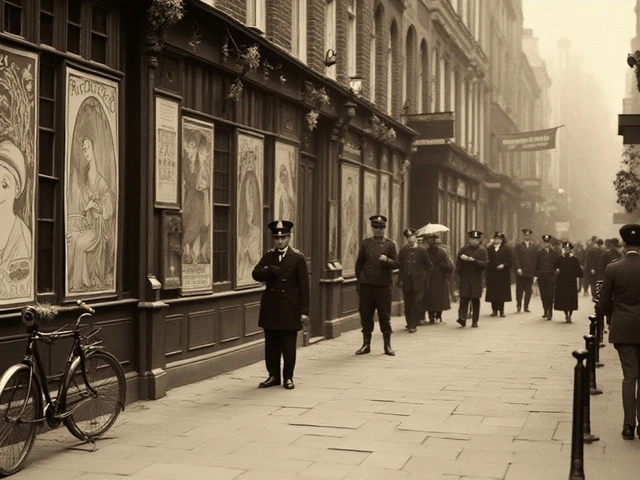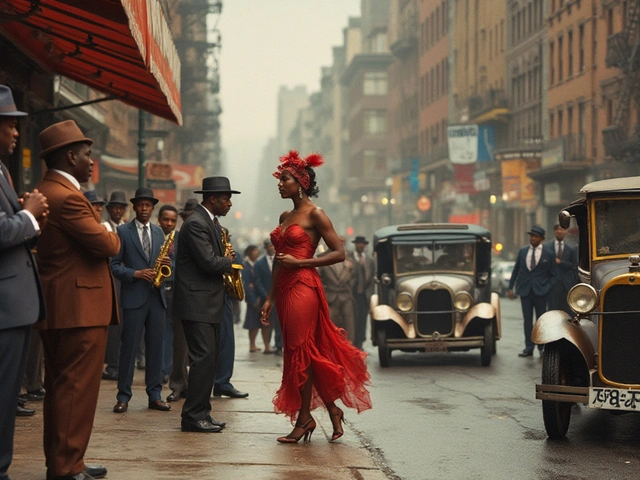Expressionism emerged as a revolutionary movement in the early 20th century, challenging the conventions of traditional art with its focus on representing raw emotion and subjective perspectives. These artists used bold colors, exaggerated forms, and dynamic compositions to express the inner turmoil and complexities of the human experience.
One of the most iconic pioneers of this movement was Edvard Munch, whose works like 'The Scream' vividly encapsulate existential angst and psychological intensity. His ability to convey profound emotion with haunting imagery set the stage for future Expressionists.
Wassily Kandinsky, another key figure, brought a unique abstract approach to the movement. His belief in color and form as conveyors of spiritual truth and emotional depth led to some of the most groundbreaking works in modern art.
- Introduction to Expressionism
- Edvard Munch: The Pioneer
- Wassily Kandinsky: The Abstract Visionary
- Egon Schiele: The Provocative Genius
- Emil Nolde: The Controversial Colorist
- Legacy and Influence of Expressionism
Introduction to Expressionism
The art movement known as Expressionism is deeply rooted in the emotional and psychological state of the human condition. Emerging in the early 20th century, this movement pushed back against the rigid and classical techniques that had dominated the art world. Instead of focusing on the external visual reality, Expressionists sought to portray the internal emotions and subjective experiences of the artist.
Expressionism didn't arise in a vacuum; it was partly inspired by the social, political, and economic turmoil of the time, including the impacts of industrialization and the lead-up to World War I. The horrors of war, the tensions of a rapidly changing world, and a focus on the individual's inner experience were central themes in the works of Expressionist artists. They used distorted forms, striking colors, and bold brushstrokes to emphasize the emotional intensity of their subjects.
One notable aspect of Expressionism is its broad geographical reach. While Germany was the embryonic center of the movement with groups like Die Brücke and Der Blaue Reiter, the influence of Expressionism spread across Europe and even to the United States. Artists like Edvard Munch from Norway and Wassily Kandinsky from Russia were pivotal in shaping the movement and gave it a diverse range of styles and interpretations.
Expressionist art is often striking and unforgettable. Faces contorted with anguish, vibrant colors that seem to pulse with energy, and landscapes that feel more like emotional states than physical places are all characteristic elements. These works often leave a lasting impression on the viewer, making them respond not just intellectually but emotionally and viscerally. As art critic Robert Hughes once observed, "Expressionism isn't a style; it's a set of attitudes."
"Art is not what you see, but what you make others see." - Edgar Degas
Expressionism also had a significant impact on other forms of art and media. The principles and visual impacts of the movement influenced theatre, literature, cinema, and architecture. German Expressionist cinema, in particular, left an enduring legacy with films like 'The Cabinet of Dr. Caligari' which used dramatic, high-contrast lighting and distorted set designs to evoke a sense of psychological horror. The movement wasn't just about painting but about an entire shift in how artists and audiences thought about and experienced art.
Edvard Munch: The Pioneer
Edvard Munch, a Norwegian painter born in 1863, is widely recognized as a pioneer in the Expressionist movement. His most famous work, 'The Scream', has become an emblem of modern existential angst. Although 'The Scream' is iconic, Munch's contributions to the art world stretch far beyond this single piece. His early life was marred by tragedy, losing his mother at the age of five and his sister soon after. These personal losses deeply influenced his work, infusing it with a sense of melancholy and existential dread.
The haunting expressions and stark, flowing lines in Munch's paintings often delve into themes of love, anxiety, and death. His piece 'The Sick Child' draws directly from personal experience, capturing the grief of losing his sister. Through his characteristic use of vibrant colors and emotional intensity, Munch created poignant art that deeply resonated with viewers. He once said, "I paint not what I see, but what I saw," emphasizing his goal to depict an internal rather than external reality. This guiding principle profoundly impacted the Expressionism movement.
"No longer shall I paint interiors with men reading and women knitting. I will paint living people who breathe and feel and suffer and love." — Edvard Munch
Munch's stylistic approach was radical for its time. His works frequently featured bold brushstrokes and non-naturalistic palettes, capturing intense emotions instead of realistic depictions. His 'Frieze of Life' series is a compelling exploration of the human condition, delving into themes of love, anxiety, and death. One of the standout works from this series is 'Madonna', which depicts a hauntingly beautiful woman with an unsettling aura, blending allure and dread in equal measure.
Munch's influence is evident in the works of later artists, who adopted and adapted his techniques to further the evolution of Expressionism. His willingness to confront difficult themes head-on broke ground for future generations. Beyond painting, Munch also made significant contributions to printmaking, utilizing techniques like etching and lithography to create impactful, emotive works on paper. His prints, much like his paintings, are celebrated for their vivid portrayal of psychological depth.
Despite facing criticism and misunderstanding during his lifetime, Munch's work eventually gained the recognition it deserved. In 1908, after years of personal turmoil and mental health struggles, Munch entered a clinic in Copenhagen. Post-recovery, his style became more optimistic and bright, although it retained its emotional intensity. His late works often portrayed serene landscapes and everyday scenes, revealing a different facet of his artistic journey.
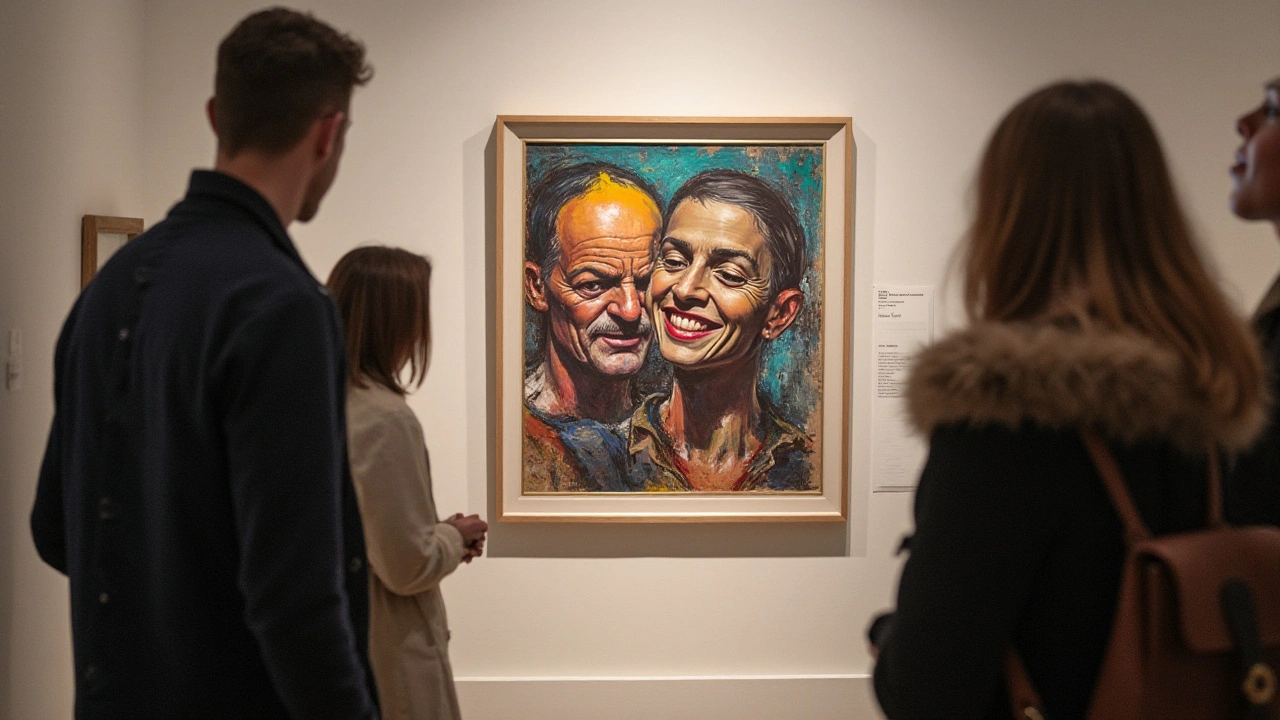
Wassily Kandinsky: The Abstract Visionary
Wassily Kandinsky, often hailed as one of the most influential figures in abstract art, revolutionized the world of modern art with his profound use of color and form. Born in Moscow in 1866, Kandinsky initially pursued a career in law and economics before dedicating himself wholeheartedly to painting. This transition marked the beginning of a journey that would see him pioneer abstract art as we know it.
What sets Kandinsky apart from his contemporaries is his firm belief in the spiritual and emotional power of art. He viewed painting as a way to capture the essence of the human spirit. Kandinsky wrote extensively on this subject, most notably in his famous work, 'Concerning the Spiritual in Art.' Here, he elaborated on his theories of color symbolism and the emotional effects of geometric forms.
"Color is a power which directly influences the soul. Color is the keyboard, the eyes are the hammers, the soul is the piano with many strings." — Wassily Kandinsky
Kandinsky's transition to abstraction was gradual. His early works, such as 'The Blue Rider' (Der Blaue Reiter), still retained a firm connection to the real world, using only mild abstraction. But as he evolved, his focus shifted entirely towards pure abstraction. By 1910, he created what is widely considered the first fully abstract painting, 'Composition VII.' The painting, a whirlwind of colors, lines, and shapes, defies any attempt at interpretation tied to the physical world.
This bold move towards abstraction was not merely an artistic choice but a spiritual one for Kandinsky. He believed that art should transcend the materialistic confines of reality and tap into deeper universal truths. His works from this period are characterized by vivid colors, dynamic compositions, and a profound sense of movement.
During his time at the Bauhaus School, Kandinsky continued to develop his theories and experiment with different art forms. Here, his works took on a more geometric nature, emphasizing the use of circles, triangles, and lines. He saw these shapes as carriers of deep, spiritual meaning. Kandinsky's influence during his Bauhaus years was enormous, shaping the school’s curriculum and inspiring many young artists.
Kandinsky’s late works, created during his time in France, display a harmonious blend of his earlier emotional energy and the disciplined structure of his Bauhaus period. Works like 'Composition X' show a mature artist at the peak of his creative powers, seamlessly merging color, form, and composition to create deeply moving abstract masterpieces.
Although Kandinsky passed away in 1944, his legacy endures in the continued relevance of abstract art. He remains a towering figure in the history of modern art, inspiring countless artists to break free from the constraints of realism and explore the boundless possibilities of abstraction. His life and work offer invaluable insights into the transformative power of art and its ability to tap into the deepest recesses of the human psyche.
Egon Schiele: The Provocative Genius
Among the powerful figures in the Expressionist movement, Egon Schiele stands out due to his radical approach to art and his ability to provoke strong reactions. Born in Austria in 1890, Schiele's work is characterized by its unique blend of eroticism, raw emotion, and stark realism. His often controversial subject matter and distinctive style made him both celebrated and vilified during his short life.
Schiele's self-portraits are among his most gripping works. He frequently used his own body as a canvas to explore themes of death, sexuality, and existential angst. His use of jagged lines and distorted forms differentiated him from his contemporaries and allowed him to delve deep into his own psyche. One can see the fear, the pain, and the desire in his evocative brush strokes.
"Art cannot be modern. Art is primordially eternal." — Egon Schiele
Another aspect that makes Schiele's work so compelling is his treatment of the human form, especially the nude. His depictions are unapologetically confrontational, often exploring taboo themes of the human condition. This fearless exploration earned him criticism and even jail time, but his refusal to compromise his vision also garnered immense respect from fellow artists and art lovers alike.
The bond between Schiele and his mentor, Gustav Klimt, is worth noting. Klimt's influence is evident in the decorative elements and richness of Schiele's early works. Yet, Schiele quickly developed his own unique voice, marked by an unsettling intensity and a stark clarity. It was this evolution that solidified his place as a quintessential Expressionist artist.
Schiele's untimely death at the age of 28 didn't stop him from leaving a lasting impact on the world of art. His daring style and exploration of darker aspects of the human experience created a legacy that continues to captivate audiences. Today, his works are displayed in prominent museums worldwide, serving as a testament to the enduring power of his art.
Expressionist Artists often seek to bypass traditional aesthetic norms to reach deeper emotional truths, and Schiele exemplified this approach. His honest and sometimes brutal representations of his subjects compelled viewers to confront their own discomfort and vulnerabilities. Schiele's work remains a groundbreaking chapter in the history of Expressionism, demonstrating that art's power lies in its ability to convey the unspoken complexities of human emotion.
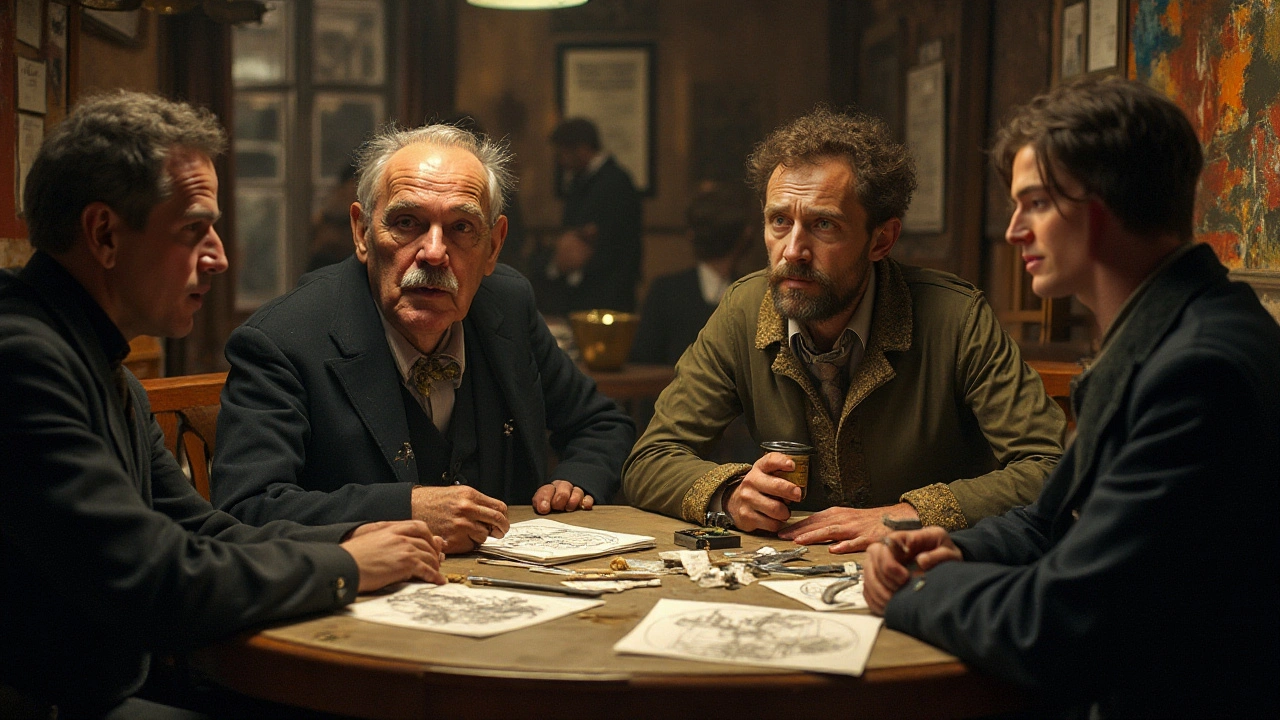
Emil Nolde: The Controversial Colorist
Emil Nolde, born Hans Emil Hansen in 1867, is often remembered as one of the most expressive and experimental painters within the Expressionism movement. His use of bold colors and dramatic contrasts took the art world by storm and left a significant mark on Expressionist art. However, Nolde's legacy is a tumultuous one, marked both by his artistic brilliance and his controversial political associations.
Nolde's early works were heavily influenced by his rural upbringing in Denmark and Germany. He first trained as a carver and a furniture designer before fully embracing painting. By the early 1900s, Nolde had developed a distinctive style characterized by vivid, almost violent use of color and intense emotion. His subjects ranged from landscapes and seascapes to religious themes and grotesque portraits.
A striking example of his intense and dramatic style is 'The Last Supper' (1909), which stirred controversy with its raw and almost grim depiction of this sacred event. Nolde's paintings often blurred the lines between beauty and horror, making him a unique voice in the Expressionist art movement. He was also a member of Die Brücke, a group of radical artists who sought to overthrow the aesthetic and moral constraints of bourgeois society.
However, Nolde's legacy is darkened by his relationship with the Nazi party. Despite being a member and supporter, his art was eventually condemned by the Nazis as "degenerate art," and many of his works were removed from German museums. This ironic twist adds a layer of complexity to understanding his contributions. As a result, his work has often been viewed through the lens of this political association, although his creative influence cannot be denied.
Emil Nolde's use of color was not just a stylistic choice but a philosophical one. He believed in the spiritual power of colors, and his work often reflects an almost mystical quality. Nolde once said, "The artist need not know very much; best of all let him work instinctively and paint as naturally as he breathes or walks." This approach is evident in his creations, which often feel spontaneous yet profoundly thoughtful.
His later years were marked by isolation and a focus on smaller, more intimate works. He continued to paint watercolors, often depicting flowers and landscapes near his home. These works, while more subdued, still carry the emotional intensity and vibrant color that marked his earlier pieces.
Despite the controversies surrounding his name, Emil Nolde remains a significant figure in the world of Expressionism. His innovative approach to color and form has inspired countless artists and continues to be celebrated in exhibitions worldwide. His life serves as a compelling study of the intersection between art, politics, and personal belief, offering a nuanced understanding of what it means to be an artist in turbulent times.
An intriguing aspect of Nolde's work is his exploration of human emotion and spirituality through color. Art historian Peter Selz noted, "Nolde's art is a strange amalgam of the romantic and the expressionistic, the passionate and the mystic." Whether admired or critiqued, Nolde's contributions to the Expressionist movement are undeniably profound, making him a complex yet endlessly fascinating figure in art history.
Legacy and Influence of Expressionism
The impact of the Expressionist art movement extends well beyond its initial flourish in the early 20th century, continuing to reverberate through the art world and broader cultural contexts. One of the significant contributions of Expressionism is its emphasis on emotional authenticity over realism, effectively altering how artists approach their craft. This shift has encouraged countless artists to explore and convey their inner emotional landscapes rather than adhere strictly to representational accuracy.
Expressionism also played a crucial role in the development of other modern art movements. The movement directly influenced the rise of Abstract Expressionism in the mid-20th century, exemplified by artists like Jackson Pollock and Mark Rothko. These artists inherited the Expressionist dedication to emotional depth but took it to new heights through their abstract techniques and large-scale canvases.
The movement’s focus on individual perspective and emotional truth found echoes in the works of numerous contemporary artists. For instance, the influence of Expressionism is evident in the bold, vivid palette and emotive strokes used by Jean-Michel Basquiat. His approach to socio-political commentary through art unmistakably carries the Expressionist DNA.
"Expressionism liberated art from the constraints of rigid representation and opened a realm of emotional freedom," art historian Jane Thompson notes in her seminal work on modern art movements.
Expressionism's influence isn’t confined to the visual arts; its impact can be seen in cinema, literature, and theater. German Expressionist films like 'The Cabinet of Dr. Caligari' use distorted sets, sharp contrasts, and dark themes to express psychological tension, setting the stage for the horror genre and film noir. Similarly, literary works by authors such as Franz Kafka and James Joyce reflect Expressionist themes of angst and alienation, delving deeply into the human psyche.
The Enduring Legacy
The legacy of Expressionism is also alive in the institutional recognition and scholarship it continues to receive. Major museums, such as the Museum of Modern Art in New York and the Tate Modern in London, have dedicated extensive exhibitions to showcasing Expressionist works. These exhibits not only display the original masterpieces but also include works inspired by those early pioneers, demonstrating the movement's enduring relevance.
Many art schools and programs now incorporate Expressionist techniques into their curricula, encouraging new generations of artists to explore the emotional and subjective aspects of their work. The movement’s enduring influence is also present at art auctions, where Expressionist pieces often command high prices, reflecting their continued importance and desirability among collectors.
| Artist | Notable Work | Year |
|---|---|---|
| Jackson Pollock | Number 1, 1950 (Lavender Mist) | 1950 |
| Jean-Michel Basquiat | Untitled | 1981 |
| Edvard Munch | The Scream | 1893 |
Expressionism's ability to remain relevant hinges on its universal appeal to human emotion and experience. By prioritizing the internal emotional world over external reality, the movement has provided a timeless framework for artists across different mediums to express their deepest thoughts and feelings.
In short, the legacy and influence of Expressionism are indelible marks on the canvas of art history. Its lessons in emotional expression and subjective experience continue to inspire and open new avenues for exploring the human condition through art.

